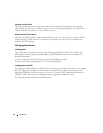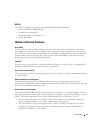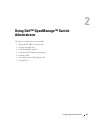
30 Introduction
Multicast Features
IPv4 Multicast Features
Updated IPv4 Multicast Routing Support
The Multicast package code has been extensively re-engineered and furnished with the following:
• PIM-DM advanced to RFC 3973
• PIM-SM advanced to RFC 4601, pim-sm-bsr-05, draft-ietf-pim-mib-v2-03
• DVMRP advanced to draft-ietf-idmr-dvmrp-v3-10.txt, draft-ietf-idmr-dvmrp-mib-11.txt
Distance Vector Multicast Routing Protocol
Distance Vector Multicast Routing Protocol (DVMRP) exchanges probe packets with all DVMRP-
enabled routers, establishing two way neighboring relationships and building a neighbor table. It
exchanges report packets and creates a unicast topology table, which is used to build the multicast
routing table. This multicast route table is then used to route the multicast packets.
Internet Group Management Protocol
The Internet Group Management Protocol (IGMP) is used by IPv4 systems (hosts and routers) to report
their IP multicast group memberships to any neighboring multicast routers. The PowerConnect
M6220/M6348/M8024 performs the "multicast router part" of the IGMP protocol, which means it
collects the membership information needed by the active multicast routing.
Protocol Independent Multicast-Dense Mode
Protocol Independent Multicast (PIM) is a standard multicast routing protocol that provides scalable
inter-domain multicast routing across the Internet, independent of the mechanisms provided by any
particular unicast routing protocol. The Protocol Independent Multicast-Dense Mode (PIM-DM)
protocol uses an existing Unicast routing table and a Join/Prune/Graft mechanism to build a tree. PIM-
DM creates source-based shortest-path distribution trees, making use of reverse path forwarding (RPF).
Protocol Independent Multicast-Sparse Mode
Protocol Independent Multicast-Sparse Mode (PIM-SM) is used to efficiently route multicast traffic to
multicast groups that may span wide area networks, and where bandwidth is a constraint. PIM-SM uses
shared trees by default and implements source-based trees for efficiency. This data threshold rate is used
to toggle between trees.


















